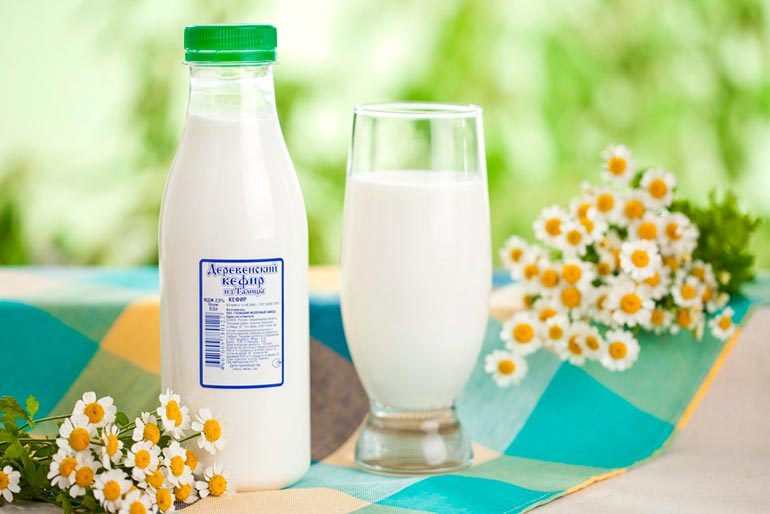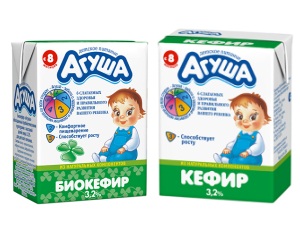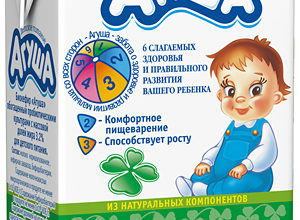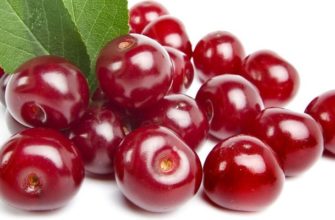Moms always wish their child all the best, so they monitor his health and development day and night. They try to feed the baby exclusively healthy food, which would not only not harm the health of the child, but on the contrary would help him to develop harmoniously. Now there are many ambiguous opinions, reviews about the benefits, as well as the dangers of kefir use by children under one year old. Is it possible to use it in a child’s diet, or is it a rather allergenic product containing alcohol? Does the digestive system normalize, or is it, on the contrary, poorly absorbed by the body?
Kefir — a fermented milk drink obtained from whole or skimmed cow's milk by fermented milk and alcohol fermentation with the use of kefir "fungi" —symbiosis of several types of microorganisms: lactic streptococci and sticks, acetic bacteria and yeast (only about two dozen). Homogeneous, white, possibly a slight emission of carbon dioxide.
The word "kefir" in translation from Caucasian means "health". Is there really any use in it, or is it all myths.

Benefit / Harm
Consider the positive properties of kefir:
- During the use of kefir, the intestinal microflora is able to recover, as well as cleanse itself of various toxins, this has a beneficial effect on the body as a whole;
- Thanks to kefir, substances such as calcium, iron and vitamin D are absorbed, which must be taken by children under 2 years old;
- Helps strengthen immunity;
- Helps improve appetite;
- Contains amino acids and vitamins, rich in calcium;
- It has an effect on the nervous system of the child. It restores the strength of the baby, gives it vivacity for the whole day, removes the first signs of fatigue;
- Useful for children with various developmental problems (ricketsanemia).
- Kefir acts as an antiseptic, since it contains lactic acid, which has a therapeutic effect in case of indigestion, infections;
- It is able to restore the baby’s body after diseases.
And now the negative ones:
- The presence of casein milk protein. There is no danger to the body of an adult, but for a baby there are certain risks. “Casein” is poorly broken down by the enzymes of a small organism; moreover, it can penetrate through the intestinal wall, thereby causing allergies;
- Kefiric acids, various mineral salts that make up its composition, have a detrimental effect on the kidneys, digestion, they act as strong irritants.
We conclude that the benefits of taking kefir are much greater, so its benefits are obvious! The main thing to observe feeding rulesthen no negative properties will have a detrimental effect on you and your little ones.
From what age to give?
There is a difference between breast-fed babies (lure for children on GV) and artificial children (feeding for children of artisans) The former may begin to receive this fermented milk product from 8 months, the latter a little earlier from 7. What is the reason for this, though not significant, difference? Eating needs for babies are different. He needs completely different mineral, protein components, so the child is able to cope with the intake of this drink only after introducing porridges, mashed vegetables, fruits into his diet. This most often occurs when the baby is 8 months old.
How to give?
When introducing kefir into a child’s diet, one should be guided by exactly the same rules as when entering any other dish. It is worth starting lure gradually. You begin to give a teaspoon, and then increase the dose, bringing it to a volume equal to 200 ml per day.
READ ALSO: rules for the introduction of the first feeding - https://kid.htgetrid.com/en/prikorm/kogda-nachinat-prikarmlivat-grudnogo-rebenka.html
We cook kefir ourselves
Below is one of the recipes for homemade yogurt. Cooking it is not so difficult, so do not think that you might not succeed.
You will need:
- pasteurized, baked or skim milk;
- the basis (sourdough) can be kefir itself, sour cream or sourdough from a pharmacy (the most common are Narine and bifidobacteria. The instructions on how to make kefir are on sourdough).
Boil a liter of milk for 5-10 minutes, then pour into a sterile glass dish. Add one or two tablespoons of sourdough, wrap and set in a warm place for 8-10 hours. Then let go in the refrigerator for 2-3 hours. Kefir can be stored at 2–4 C for no more than 3 days.Giving it to the crumbs is slightly warm.
“I do this: I take 0.5 liters. fresh milk, warm it, but not boil! I add 2-3 table to warm milk. tablespoons of fresh sour cream, and overnight in a warm place! ”
“In our village, women shared kefir fungi with each other, 1/4 teaspoon of fungi pour a glass of milk for 12 hours or a day (I don’t remember exactly) and we get baby kefir. Now there are a lot of things for sour milk children in children's mall. kitchens, pour 3-40 grams with a glass of milk - and there will be kefir, this lactic acid bacteria multiply. ”
Sour cream fermentation: Pasteurized and whole milk can be used. The latter must be boiled for 5-7 minutes. We take a glass of milk (200 ml), boil, add 1 tablespoon of sour cream and set to sour at room temperature for 10 hours. Then sugar can be added to the resulting kefir to the taste of the baby. Keep refrigerated.
Kefir fermentation: You need to cook directly the starter itself. In 100 ml of boiled milk at room temperature add 1 tbsp. a spoonful of one-day kefir. Insist for 12 hours. Fermentation time of the starter culture can be increased in the cold season to 24 hours. Store sourdough in the refrigerator. The preparation of kefir itself: in 200 ml of boiled warm milk add 100-150 ml of starter culture. Insist for 10-12 hours, add sugar to taste.
Ferment of Narine: Kefir, prepared with the help of Narine sourdough, is not only tasty, but also healthy. This yogurt can stabilize the intestinal microflora, it will also be better absorbed calcium, reduce allergic alertness of the body (and in some cases the food allergy disappears). And only it can be given to children from birth. You have to tinker with such a kefir, but it's worth it.Preparation of the main starter culture: boil 500 ml of milk for 10-15 minutes, then cool to 39-40 C. In a pre-prepared sterilized glass dish, mix 1 bottle of starter culture (0.3 L) and milk. Close tightly, wrap and put in a warm place for 10-16 hours. The color of the finished sourdough is light cream (may be white), the consistency is viscous. Next, cool in the refrigerator to a temperature of 2-6 C. Store the starter in the refrigerator at a temperature of 2-4 C.
[sc: rsa]
Bifidobacteria fermentation:Such kefir is often recommended by pediatricians. First, prepare the starter: in boiled milk (40 C, 200 ml) add 1 bottle of bifidobacteria (5 doses) and 30 g of sour cream. Insist 2-3 hours in a warm place. We prepare kefir: 200 ml of boiled milk at room temperature, 1 tablespoon of sourdough. Mix and infuse for 12 hours at room temperature. The finished product can be stored in the refrigerator.
And the easiest way: Mix boiled milk and kefir in a ratio of 3: 1, insist at room temperature for 12 hours. Place the finished product in the refrigerator.
Watch a video how to make homemade kefir (yogurt):
And one more recipe:
What is the difference between kefir for “children” and for “adults”? Is there a difference?
 Children's has a much lower fat content, namely 2.5%. It is enriched with various vitamins and minerals. The milk and sourdough used for its manufacture is of the highest quality. Products intended for children are more stringent. However, do not forget to independently check the storage conditions of kefir and its shelf life, since poisoning carries a great danger. Also review the composition. It should not contain any dyes, preservatives, starch, fillers or additives with the letter E. Only milk, starter culture on fungi. When you see a package of kefir in the store that meets all the above requirements, feel free to buy it, in this case you can not worry about the health of your baby. Popular brands of baby kefir: Agusha and Tema.
Children's has a much lower fat content, namely 2.5%. It is enriched with various vitamins and minerals. The milk and sourdough used for its manufacture is of the highest quality. Products intended for children are more stringent. However, do not forget to independently check the storage conditions of kefir and its shelf life, since poisoning carries a great danger. Also review the composition. It should not contain any dyes, preservatives, starch, fillers or additives with the letter E. Only milk, starter culture on fungi. When you see a package of kefir in the store that meets all the above requirements, feel free to buy it, in this case you can not worry about the health of your baby. Popular brands of baby kefir: Agusha and Tema.
READ ALSO: milk for children under one year old
Dr. Komarovsky about the dangers of kefir
[sc: ads]









I gave the child kefir up to a year, and my daughter drank it with pleasure. My joy was not thinned, because it is very useful. But after a year when the daughter began to try more and more new products, she herself refused kefir. We are almost 2 now, but we don’t drink kefir. Oh, so sorry! By the way, there were no problems with the tummy
My baby was just one of those who refused to drink plain kefir. Purchased children went for a sweet soul, but did not drink a home one in any way. We are 2.5, we still drink purchased, 1-2 times a week, because it's quite expensive (
Strongly against kefir in the children's diet, especially to such babies.A certain percentage of the alcohol that is released during the process of alcoholic fermentation is not necessary for the child. I understand that if there were no alternatives, but the 21st century in the yard and the options for sour milk to infants are numerous. As for Narine, there is also kefir fungus (yeast) and the same alcoholic fermentation. True, there are starters for home-made Narine, where there is no yeast. By the way, it seems that Bakzdrav, which many people write about above, does not have kefir fungus and yeast in the ferment for Narine, respectively.